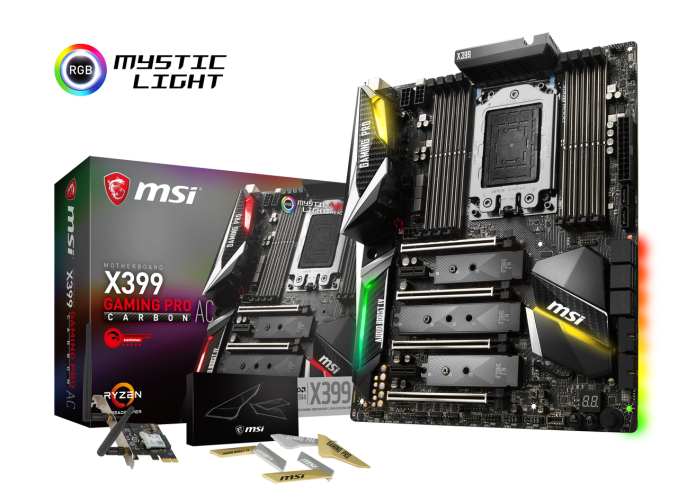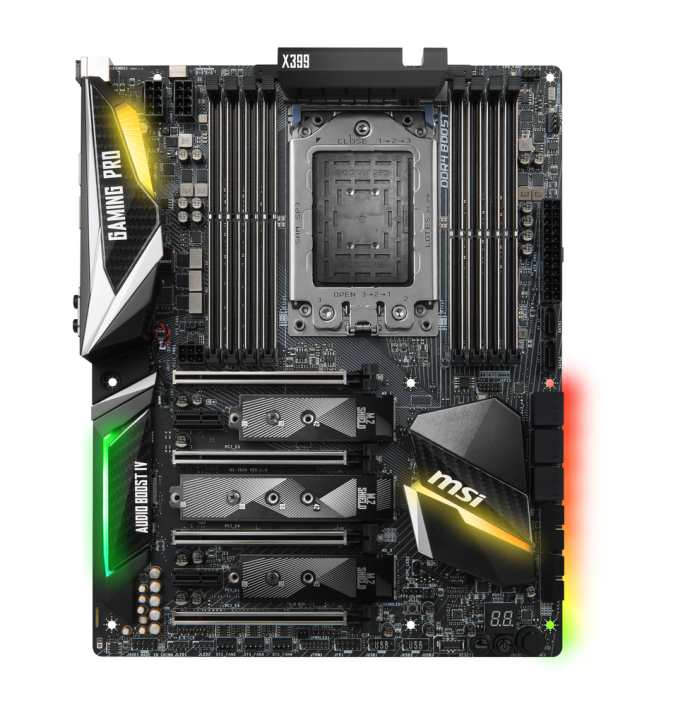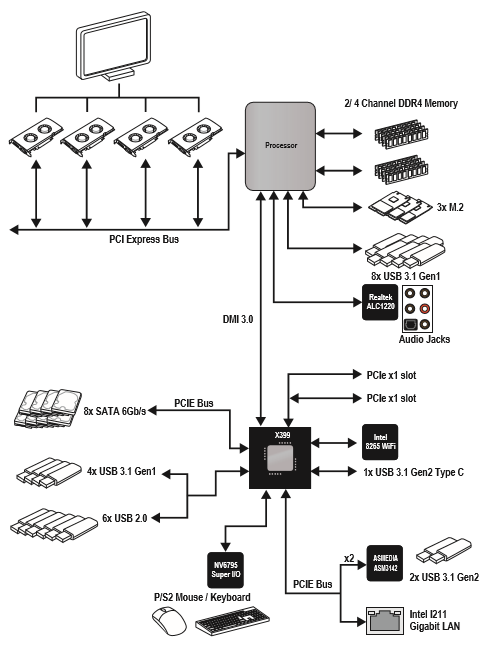An AMD Threadripper X399 Motherboard Overview: A Quick Look at Seven Products
by Ian Cutress & Joe Shields on September 15, 2017 9:00 AM ESTMSI
MSI's initial offering in the X399 space comes in the form of Gaming Pro Carbon AC. This board sits as the high-end board within the Performance Gaming lineup in previous generations. The Gaming Pro Carbon series tends to features for gamers and enthusiasts, using modern audio codecs, wireless capabilities, and aiming for high overclocking abilities.
The MSI X399 Gaming Pro Carbon AC
Starting with the DRAM, we see eight slots covered with MSI's Steel Armor. Memory capacity is the same as other boards, holding up to 128GB in a quad channel configuration, and MSI promotes a maximum supported speed of DDR4-3600, although higher might be possible through overclocking further. MSI is promoting its DDR4 Boost technology, which they say optimizes the traces and fully isolates the memory circuitry for increased stability and performance.
Power delivery for the X399 Gaming Pro Carbon AC is handled by International Rectifier based DrMOS ICs. These are likely either IR3556 or IR 3555 PowIRstages, so either 50A or 60A each. The controller is said to be the IR35201. Power is fed to the VRM by 2x 8-pin 12V CPU (one is optional) located in the upper left-hand corner between the memory slots and rear I/O area. The board has an 8 layer PCB design which MSI mentions is designed to increase efficiency and stability over a standard PCB (it is worth noting that no-one uses a 'standard PCB' for X399). Preaching top quality and stability again, MSI's states its Titanium-II chokes, Dark Caps, and Dark Chokes are 'Military Class 6' certified. The VRM heatsink is unusually tall, to negate the fact it is not connected to anything, but is made out aluminum.
Moving down the board a bit, we can identify four full-length PCIe slots also protected by MSI's Steel Armor surrounding the slots. The Gaming Pro Carbon AC supports 4-Way SLI/Crossfire. In addition to the four full-length connections are two PCIe 2.0 x1 slots fed from the chipset.
For storage purposes, the motherboard has a total of eight SATA ports, six of which are horizontally mounted, while the other two are vertical. There are three M.2 slots also, all of them supporting both PCIe 3.0 x4 drives and SATA drives. Two of the three slots can hold up to a 80mm drives, while the middle M.2 can hold a 110mm drive. All the M.2 ports are nestled between PCIe slots, and use an 'M.2 Shield' to aid with heat dissipation. Unlike some of the other boards, U.2 does not make an appearance on the Gaming Pro Carbon.
Audio output is handled by the Realtek ALC1220 codec working with MSI's Audio Boost 4 suite. MSI updated the Nahimic sound technology to Nahimic 2+, and is now able to apply its audio effects through S/PDIF and Optical connections for non-encoded formats. There is also a dedicated headphone amplifier which auto-detects impedance such that headphones up to 600Ω can be used. The Gaming Pro Carbon also features board isolation of the channels in separate layers of the PCB, filter caps, EMI protection on the audio processor itself (includes built-in DAC), as well as isolation of the audio circuitry from the rest of the motherboard.
RGB LEDs make an appearance on this board as well. Somewhere between the understated ASRock boards and well below the Gigabyte light show is where the Gaming Pro Carbon lands on the spectrum. We can see the LEDs on the rear I/O cover and above the audio on the left-hand side of the board, as well as the chipset heatsink. The last set of LEDs is located under the board below the SATA ports. The Pro Carbon also has two more headers for RGB strips. One for general RGB and the other a rainbow strip. MSI's Mystic Light software controls all the RGB LED functions including those connected to the headers.
MSI included a block diagram of how they break all the lanes down from the CPU and chipset to attached devices.
Below is a complete list of specifications.
| MSI X399 Gaming Pro Carbon | |
| Warranty Period | 3 Years |
| Product Page | Link |
| Price | $379.99 |
| Size | ATX |
| CPU Interface | TR4 |
| Chipset | AMD X399 |
| Memory Slots (DDR4) | Eight DDR4 Supporting 128GB Quad Channel Up to 3600 MHz (OC) Supports ECC UDIMM (in non-ECC mode) |
| Network Connectivity | 1 x Intel I211 Gigabit LAN controller |
| Onboard Audio | Realtek ALC1220 |
| PCIe Slots for Graphics (from CPU) | 4 x PCIe 3.0 x16 |
| PCIe Slots for Other (from Chipset) | 2 x PCIe 2.0 x1 |
| Onboard SATA | 8 x Supporting RAID 0/1/10 |
| Onboard SATA Express | None |
| Onboard M.2 | 3 x PCIe 3.0 x4 - NVMe or SATA |
| Onboard U.2 | None |
| USB 3.1 | 1 x Type-C (ASMedia) 1 x Type-A (ASMedia) 1 x Header (Chipset) |
| USB 3.0 | 8 x Rear Panel 2 x Header |
| USB 2.0 | 2 x Rear Panel 2 x Header |
| Power Connectors | 1 x 24-pin ATX 2 x 8-pin CPU 1 x 6-pin PCIe |
| Fan Headers | 1 x CPU (4-pin) 1 x Water Pump (4-pin) 4 x System Fan (4-pin) |
| IO Panel | 1 x Clear CMOS button 1 x BIOS FLASHBACK+ button 1 x PS/2 keyboard/mouse combo port 2 x USB 2.0 Type-A ports 8 x USB 3.0 Type-A ports 1 x LAN (RJ-45) 1 x USB 3.1 Type-A port 1 x USB 3.1 Type-C port 5 x Audio Jacks 1 x Optical S/PDIF OUT connector |

















99 Comments
View All Comments
BoemlauweBas - Friday, October 20, 2017 - link
The fact you still can't buy them is one thing, and it will be expensive. Then again, if money ain't a thing & you'll agree one kidney should be enough for anyway. Buy this for your (Yes, it's in the sales sheet) for you games / media. For the real OG's would go for something like Sandisk's Infiniflash.....I know right .... https://www.youtube.com/watch?v=iWvrOItRSyQ
plonk420 - Tuesday, September 19, 2017 - link
you go fairly high end motherboard, but then you get terrible SATA cards? ಠ_ಠyeah, do like Supermicro (there's a couple cards low $100s) or at least that Adaptec.
just like IDE cards back in the day... buy a crap card, get crap performance.
mapesdhs - Tuesday, September 19, 2017 - link
It's a shame Intel's never made a PCIe card using its own controller, because of course Intel's SATA3 ports on its own boards always work nicely. But then, if they did, loads of people would buy the card to fit to older boards (especially X58, Z68, X79, etc.) instead of upgrading to a newer board, and it'd be cool to have such an option for AMD boards aswell. Never gonna happen though I guess.Oksana - Saturday, September 19, 2020 - link
I really like Thunderbolt, but also want to build a Threadripper computer. Is it possible to have the best of both worlds and add a thunderbolt card?ddriver - Friday, September 15, 2017 - link
It has six. How much do you need? Considering it also has 3 M2 slots.That 10 gbit lan card is for connecting to a proper nas server. You don't cram a workstation with a dozen HDDs.
nathanddrews - Friday, September 15, 2017 - link
I'm not building a workstation.ddriver - Friday, September 15, 2017 - link
So you are building a file server then? Senseless choice of hardware then ;)HomeworldFound - Friday, September 15, 2017 - link
A file server is a good wife excuse to build with a Threadripper. He can pretend he needs one core per hard drive and in order to stream video to more than one TV he needs two GPUs. It works.ddriver - Friday, September 15, 2017 - link
So a dumb wife having to approve your purchases is a realistic scenario? :DHomeworldFound - Friday, September 15, 2017 - link
In my location telling people that you can build a computer makes people want to touch you.